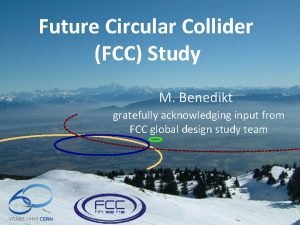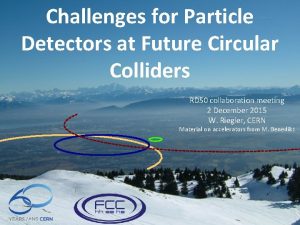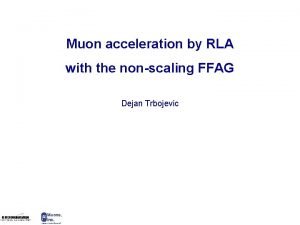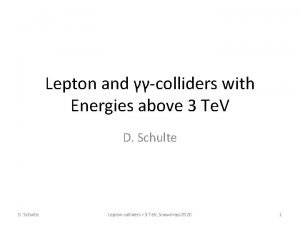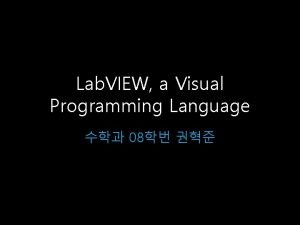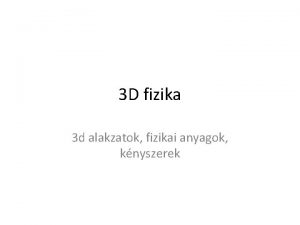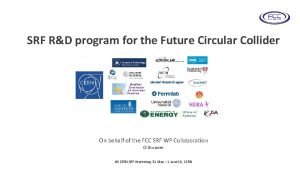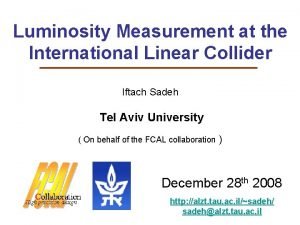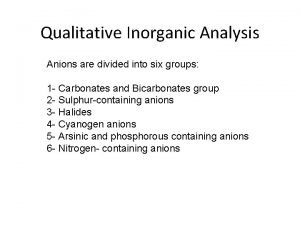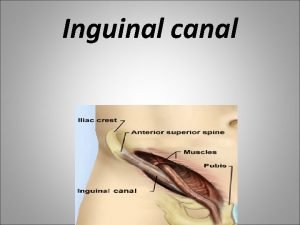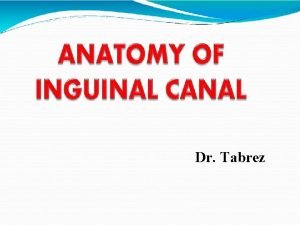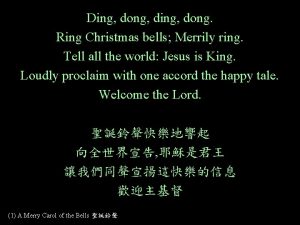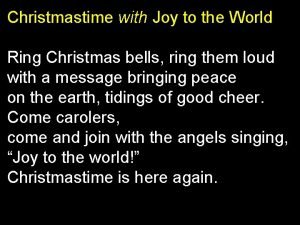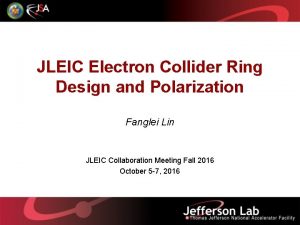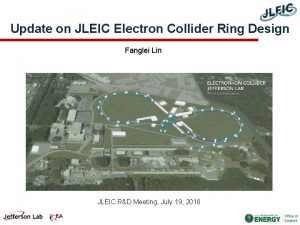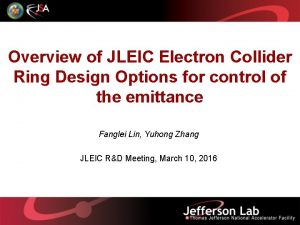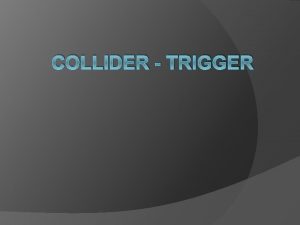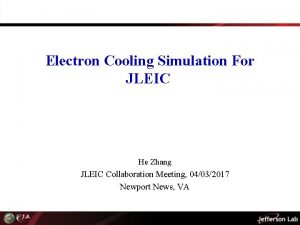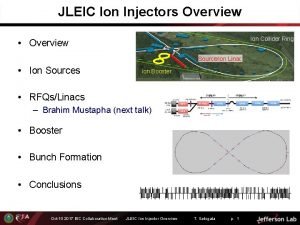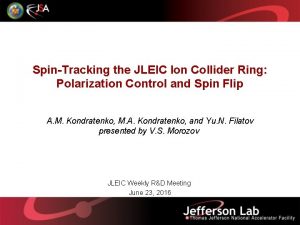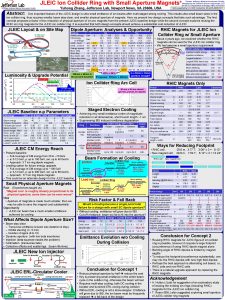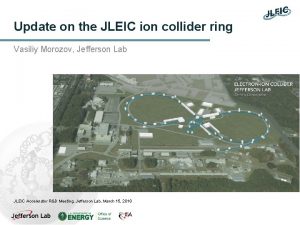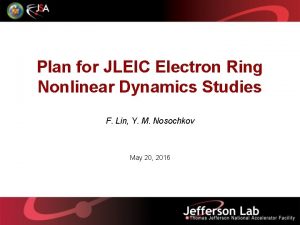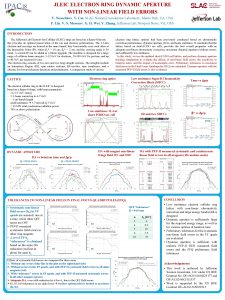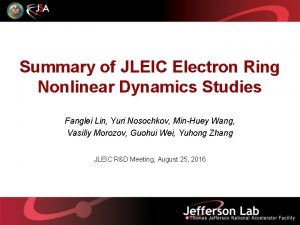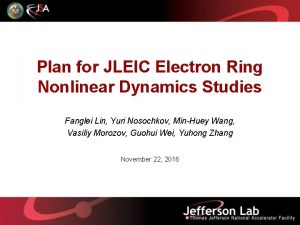Alternate JLEIC Electron Collider Ring Designs Use New















- Slides: 15

Alternate JLEIC Electron Collider Ring Designs --- Use New Magnets to Obtain a Small Emittance Fanglei Lin JLEIC R&D Meeting, August 4, 2016

Electron Ring Baseline Design Layout Circumference of 2154. 28 m = 2 x 754. 84 m arcs + 2 x 322. 3 straights Sp in or ro tat or R= 310 m 15 5 m in Sp T St une ra tr ig om ht FO bon DO e s & B e. Future 2 nd IP RF RF Sp r to n i Sp ta ro r CC 81. 7 Arc, 261. 7 t ota in r IP ota t or Forward e- detection 784 m 2

Summary of Baseline Design 2. 2 km electron collider ring was design reuse of PEP-II HER magnets mostly Two arcs are composed of 15. 2 m long FODO cells, dispersion suppression sections and spin rotators – FODO cell and dispersion suppression (PEP-II magnets) • dipole 5. 4 m, bending angle 2. 8 , bending radius 110. 5 m, sagitta 3. 3 cm, 0. 3 T @ 10 Ge. V, can reach 0. 362 T @ 12 Ge. V with only ~0. 2% saturation • Quadrupole 0. 56 m, field gradient <13 T/m @ 10 Ge. V with saturation <0. 4%, gradient ~14 -15 T/m @ 12 Ge. V with saturation up to ~6% • 108 /108 x/y betatron phase advance in FODO cell – Spin rotators have new dipoles, solenoids and quads (~25 T/m @ 10 Ge. V). Straight FODO cells, tune trombone and matching sections use PEP-II 0. 73 m-long PEP-II quads and some new quads Chromaticity compensation block, RF sections and detector region use new dipoles and quads. Arcs contribute ~90% emittance and ~30 -40% chromaticities. 3

Approaches of Reducing Emittance All following options have been investigated – Optimizing of sections, such as matching section, spin rotator, etc. , to reduce the emittance contribution (30%) • Pros: do not change the optics of the rest of the ring, except some particular sections • Cons: ~110 m additional space and 16 quads are needed – Adding (dipole) damping wigglers (50% @ 5 Ge. V) • Pros: do not change the baseline design, fast damping • Cons: need wigglers, more radiation power, larger energy spread (a factor of 2), high RF peak power if keep the same bunch length, not suitable at higher energies, may affect the polarization lifetime – Offsetting the beam in quads (~ 7 to 8 mm) in arcs (48%) • Pros: do not change the baseline design • Cons: larger energy spread (a factor of 2), longer (maybe) bunch length, have to center the sextupoles – New magnets (instead of PEP-II magnets) ring but still FODO cell arcs (50%) • Pros: small dipole bending angle results in small emittance and no sagitta issue • Cons: all new magnets, large chromaticities, strong sextupoles for chromaticity compensation due to small dispersion – Different types of arc cell, such as DBA, TME (> 50%) Need combine nonlinear dynamic studies • Pros: much smaller emittance comparing to the FODO cell • Cons: more quads, stronger quads, larger ring (possible), large chromaticities, chromaticity compensation scheme 4

New Magnet FODO Arc Cell e-Ring Complete electron collider ring optics – circumference of 2181. 89 m = 2 x 809. 98 m arcs + 2 x 280. 97 m straights 5

New Magnet FODO Arc Cell Arc FODO cell (Each arc has 54 such normal FODO cells) – Length 11. 4 m (half of ion ring arc cell) – arc bending radius 155. 45 m – 108 /108 x/y betatron phase advance Dipole – – Magnetic/physical length 3. 6/3. 88 m Bending angle 36. 7 mrad (2. 1 ), bending radius 98. 2 m 0. 34 T @ 10 Ge. V (0. 41 @ 12 Ge. V) Sagitta 1. 65 cm New Quadrupoles – Magnetic/physical length 0. 56/0. 62 m – 17. 5 T/m field gradients @ 10 Ge. V (21 T/m @ 12 Ge. V) – 0. 88 T @ 50 mm radius @ 10 Ge. V (1. 06 T @ 12 Ge. V) Sextupoles – Magnetic/physical length 0. 25/0. 31 m – -624 and 262 T/m 2 field strengths @ 10 Ge. V for chromaticity compensation of the whole ring – 1. 2 T and 0. 5 T @ 60 mm radius @ 10 Ge. V (1. 4 T and 0. 6 T @ 12 Ge. V) BPMs and Correctors – Physical length 0. 05 and 0. 3 m 6 Baseline

Comparison of e-Ring Parameters Baseline design (FODO arc cell) w/ PEP-II magnets Optimized baseline design (FODO arc cell) w/ PEP-II magnets New design (FODO arc cell) w/ new magnets m 2154 2186 2182 Bending angle per arc / figure-8 crossing angle deg 261. 7 / 81. 7 Beta stars at IP *x, y cm 10 / 2 -149 / -123 -113 / -120 -127 / -140 2. 2 1. 9 1. 1 (reduce bunch length or Ring circumference Hor. / ver. chromaticities x, y Momentum compaction factor 10 -3 V_peak ? ) Energy spread @ 5 and 10 Ge. V 10 -4 4. 6 / 9. 1 4. 5 / 9. 0 4. 6 / 9. 3 Normalized emittance @ 5 and 10 Ge. V rad 137 / 1093 93 / 740 54 / 433 Hori. beam sizes at IP @ 5 and 10 Ge. V m 38 / 75 31 / 62 24 / 47 m 15. 2 (PEP-II cell length) 11. 4 (half of ion ring arc cell) dipole length / sagitta m / cm 5. 4 / 3. 3 3. 6 / 1. 65 dipole bending angle / radius deg / m 2. 8 / 110. 5 2. 1 / 98. 2 quad length/strength @ 10 & 12 Ge. V m / T/m 0. 56 / 13 / 15. 6 0. 56 / 17. 5 / 21 42 44 58 Arc FODO cell (2 dipoles, 2 quads per cell) length cells per arc (including dispersion suppresser, no spin rotator) 7

Momentum Acceptance & Dynamic Aperture First look of momentum acceptance and dynamics aperture at 5 Ge. V by using 2 sextupole families for linear chromaticity correction only, no errors. Chromatic tunes and chromatic * Dynamic aperture (-7, +13)σ p/p ± 20 σx 8

New Magnet TME-like Arc Cell e-Ring Complete electron collider ring optics – circumference of 2166. 82 m = 2 x 786. 08 m arcs + 2 x 297. 33 m straights 9

New Magnet TME-like Arc Cell Arc TME-like cell (Each arc has 26 such normal TME-like cells) – Length 22. 8 m (same as ion ring arc cell) – arc bending radius 155. 45 m – 270 /90 x/y betatron phase advance Dipole – – Magnetic/physical length 4. 0/4. 28 m Bending angle 36. 7 mrad (2. 1 ), bending radius 109. 1 m 0. 31 T @ 10 Ge. V (0. 37 @ 12 Ge. V) Sagitta 1. 83 cm Quadrupoles – Magnetic/physical length 0. 56/0. 62 and 1. 0/1. 06 m – 20 T/m field gradients @ 10 Ge. V (24 T/m @ 12 Ge. V) – 1. 0 T @ 50 mm radius @ 10 Ge. V (1. 2 T @ 12 Ge. V) Sextupoles – Magnetic/physical length 0. 25/0. 31 m – 400 and 604 T/m 2 field strengths @ 10 Ge. V for chromaticity compensation of the whole ring – 0. 72 T and 1. 08 T @ 60 mm radius @ 10 Ge. V (0. 86 T and 1. 3 T @ 12 Ge. V) BPMs and Correctors – Physical length 0. 05 and 0. 25 m 10

Comparison of e-Ring Parameters Optimized baseline design (FODO arc cell) w/ PEP-II magnets New design (FODO arc cell) w/ new magnets New design (TME arc cell) w/ new magnets m 2186 2182 2167 Bending angle per arc / figure-8 crossing angle deg 261. 7 / 81. 7 Beta stars at IP *x, y cm 10 / 2 -113 / -120 -127 / -140 -152 / -150 1. 9 1. 1 (reduce bunch length or 0. 5 (reduce bunch V_peak) length or V_peak) Ring circumference Hor. / ver. chromaticities x, y Momentum compaction factor 10 -3 Energy spread @ 5 and 10 Ge. V 10 -4 4. 5 / 9. 0 4. 6 / 9. 3 4. 5 / 9. 1 Normalized emittance @ 5 and 10 Ge. V rad 93 / 740 54 / 433 31 / 247 Hori. beam sizes at IP @ 5 and 10 Ge. V m 31 / 62 24 / 47 18 / 36 m 15. 2 (PEP-II cell length) 11. 4 (half of ion ring arc cell) 22. 8 ( ion ring arc cell) dipole length / sagitta m / cm 5. 4 / 3. 3 3. 6 / 1. 65 4. 0 / 1. 83 dipole bending angle / radius deg / m 2. 8 / 110. 5 2. 1 / 98. 2 2. 1 / 109. 1 quad length/strength @ 10 & 12 Ge. V m / T/m 0. 56 / 13 / 15. 6 0. 56 / 17. 5 / 21 0. 56, 1. 0 / 24 44 58 28 Arc TME-like cell (4 dipoles, 4 quads per cell) length cells per arc (including dispersion suppresser, no spin rotator) 11

Momentum Acceptance & Dynamic Aperture First look of momentum acceptance and dynamics aperture at 5 Ge. V by using 2 sextupole families for linear chromaticity correction only, no errors. Chromatic tunes and chromatic * Dynamic aperture (-12, +12) σ p/p ± 10 σx 12

Summary of Three Optics Designs Optimized baseline e-ring design with FODO arc cells (PEP-II magnets) New magnet e-ring design with FODO arc cells ± 20σx (-7. 8, +5. 6) σ p/p ± 20 σx (-7, +13)σ p/p New magnet e-ring design with TME-like arc cells ± 10 σx (-12, +12)σ p/p 13

Thank You for Your Attention ! 14

Coupled Emittance In an electron storage ring without vertical bending and coupling, the natural horizontal emittance can be calculated by and the natural vertical emittance usually is a few orders of magnitude smaller than the horizontal one. A coupling effect can be introduced to a flat electron ring to obtain a nonflat beam. – Assume the emittance coupling ratio k= y/ x , then Here x, 0 is the natural horizontal emittance. They satisfy x + y = x, 0, and it has x/ x, 0=1/(1+k). JLEIC requires non-flat electron beams with k= y/ x=1: 5. Then x/ x, 0=0. 83. – I used the uncoupled natural horizontal emittance x, 0 for the calculation of horizontal beam size, and x, 0/5 for the calculation of vertical beam size. The beam sizes are overestimated by ~10%. 15
 Fcc collider
Fcc collider Fcc collider
Fcc collider Muon collider
Muon collider Muon collider
Muon collider Visual basic programming language
Visual basic programming language Unity sphere collider
Unity sphere collider Hadron collider
Hadron collider Hadron collider
Hadron collider Fcc-ee
Fcc-ee International linear collider
International linear collider What is the brown ring in the brown ring test
What is the brown ring in the brown ring test Constriction ring and retraction ring
Constriction ring and retraction ring Superfacial inguinal ring
Superfacial inguinal ring Conjoint tendon
Conjoint tendon Ding dong, ding dong christmas bells are ringing
Ding dong, ding dong christmas bells are ringing Wise men gifts
Wise men gifts
